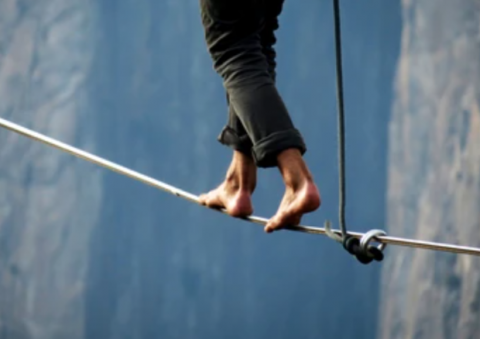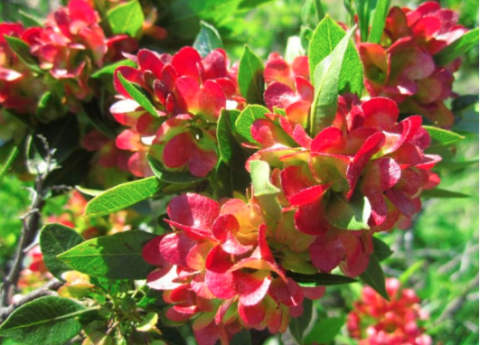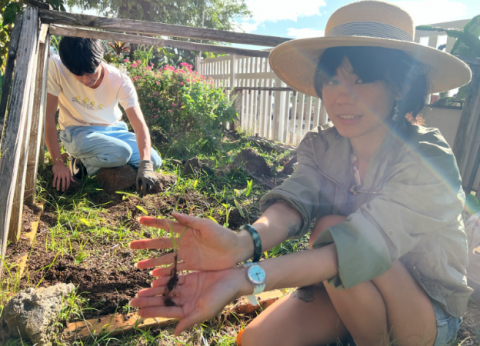In our first GCSE essay last October, we presented a method for Reframing Sustainability Education to include the weaving of Indigenous knowledge systems and decolonizing higher education as a necessary and critically missing piece of our work and practice in sustainability. We proposed that to walk the talk of sustainability education in a meaningful way, we need to practice resilience - tending overall wellbeing - from the inside out. From our homes to our neighborhoods to the world. From the personal to the interpersonal. Read the October essay here.
Resilience from the inside out applies not just to our students, but to our faculty, staff, administrators, leadership and the curriculum itself. The world is only going to become more challenging, and prone to systemic failures and collapse. As sustainability educators and leaders, we need to be prepared. This means planning for things to fail, planning for things to get hard – very hard. We must create plans and systems to cope both professionally and personally. That means building our resilience skillsets and leaning into proactive practice as part of everyday life.

To lean into this resilience practice we offer the metaphor of the high-wire, and the safety net. We need to weave and mend our nets so we can catch ourselves when we fall. With more nodes in our net we can absorb the short-term shocks and long-term impacts to bounce back better. The nodes are teachings, practices, people (human and non-human) and places that help us ground and return to center. When we fail, the more nodes we have, the tighter the weave of our nets, the less likely we are to fall through the holes, and the greater the cushion will be to catch us and help us bounce back better. Resilience is about planning for the storms of life that knock us off balance. We have to plan to be knocked off the high-wire, and to do this well, most of us have a lot of repair work to do.
To mend our resilience nets we need to reconnect with the land; to the wisdom of the land, the first teachers, the oceans, earth, and stars. Our teachers are all around us if we can slow down to listen – truly listen and become ready.
Today we offer the ‘ike of He ‘a‘ali‘i kū makani mai au; ‘a‘ohe makani nāna e kūla‘i. Which means “I am a wind-withstanding ‘a‘ali‘i; no wind can topple me over.” The small ‘a‘ali‘i shrub has a tap root that grows deep into the ground. Let us grow our roots down deep and look to nature to find our center. Hawaiian cultural practices teach of the inextricable link between culture, people, and land. These teachings are the nodes we need to mend the net.

On campus, we can look to and learn from this ‘ike kūpuna, or ancestral knowledge, as we honor our kuleana (responsibility) to care for the land and waters. It is time to find ways to actively weave these teachings with STEM, Social Science, and Sustainability Education to address the grand challenges of climate change and increase our resilience to the inevitable shocks and stressors of future disasters.
CERENE in the Eye of the Storm
We are mending our nets, tending our gardens and actively listening to the wisdom of those who have come before us at Kapi’olani Community College through the Center for Resilient Neighborhoods (CERENE). CERENE is growing into its vision of becoming a thriving hub across the island, supporting community resilience, environmental sustainability, and climate change adaptation. CERENE seeks to become a hub at the center of a network of community resilience hubs, convening, coordinating, and supporting collaboration and co-learning island-wide at the neighborhood scale. By working at this scale CERENE grounds resilience, sustainability and climate change mitigation strategies in place and people.
At the heart of CERENE are student leaders who engage with on-campus and off-campus community partners in support of resilience service learning and active learning projects through the Resilience Corps Leadership (RCL) Award Program. These students represent the next generation of sustainability and resilience researchers, professionals, educators and neighborhood residents who can integrate sustainability and resilience competencies into their careers and communities. Student leaders, upon graduating the program, stay on as undergraduate research assistants and summer interns in support of islandwide resilience planning through the Action 15 Community Resilience Hubs Project.

Campus Sustainability, Service, and Relationships for Resilience
CERENE works closely with the Faculty Senate Sustainability Committee that manages an Academic Subject Certificate (ASC) in Sustainability. Since the launching of ASC in Sustainability in 2018, the Sustainability Committee has approved 33 Sustainability-focused courses. Many of these courses integrate service-learning partnerships, such as our “Growing Community” mentoring project at nearby Waikiki Elementary School. English and Philosophy students from Kapi'olani Community College regularly visit the educational food farm at Waikiki Elementary to mentor their younger counterparts. One of the central activities is learning about ecology and Hawaiian culture through work at the food farm.
All the efforts are based on our conviction that sustainability and resilience are best taught in the weaving process of meaningful relationships. If we as researchers, professionals, educators and neighborhood residents cannot lead by example, it will be extremely difficult to expect students to connect the dots.
Strategic Planning
The same conviction of cultivating meaningful relationships also inspires the collaboration of CERENE and the Faculty Senate Sustainability Committee to build communication channels with campus administrators. As such, we have been participating in campus strategic planning conversations associated with student success, campus responsibility, and metrics. We recently welcomed a new team of campus leadership (including the chancellor and vice chancellors) just as we encountered a “wobble” with our Waikiki Elementary work…
About halfway into our project at Waikiki Elementary, we got some difficult news: one of the teachers who cultivated the garden, and also the children’s love for the garden, told us that he wouldn’t be able to continue. The reasons were mostly financial, and students started asking systemic questions: Where does the public funding for sustainability education come from? What are the critical links between huge socio-political forces and this one beautiful garden?
“This week, my mind is far from the sustainability of soil,” one student reflected, “but on the sustainability of the way people are valued, appreciated, and taken care of.”
It was appropriate that we encountered this wobble just as we were meeting with our new Chancellor about the role of sustainability on campus. She emphasized campus diplomacy to help others see the “universals” inherent in sustainability and encouraged us to reflect on how we effectively share what we do as sustainability educators. Our final meeting for the Waikiki project was a group reflection, and some students turned it into an exploration of those very questions. One student offered: “What we did was nice, but that was just hanging out with kids. How can we actually do something?”
The same kinds of questions came up in our discussion with a Vice Chancellor about integrating sustainability into the strategic plan. What do these words we’re dissecting for an administrative document actually mean in practice, here and now? We agreed that relationships can make all the difference. We agreed that the Faculty Senate Sustainability Committee could be helpful by sharing what we do at next year’s convocation. Faculty can give incoming students a dynamic interdisciplinary presentation–through the lenses of both the sciences and humanities–about how we can be resilient in this frayed world. But the underlying message, beneath the academic stuff, is simple. We care about you on this campus. No matter what happens, we want you to be ok. We are a community that does many small things that add up to something bigger.
Or, as one student in the Waikiki Elementary School Garden Mentoring Project put it, “we are gardeners.” Gardeners tending to the wellbeing of each other, ourselves, and the land.

Conclusion
In the pursuit of building resilience and cultivating sustainable futures, we find ourselves at a crossroads, facing the challenges of an uncertain world. The metaphor of mending nets reminds us of the importance of preparing for failure, planning for hardships, and developing the skills to bounce back stronger. As sustainability educators and leaders, we must embrace resilience from the inside out, from the personal to the interpersonal, and from our homes to our neighborhoods. We must draw wisdom from the land, honor ancestral knowledge, and weave together diverse knowledge systems to address the grand challenges of climate change. Together, we can mend our nets, nurture meaningful relationships, and create a thriving future for ourselves, our children, and our planet.
Opinions expressed in this essay are those of the authors. They do not purport to reflect the opinions or views of the GCSE or its members.